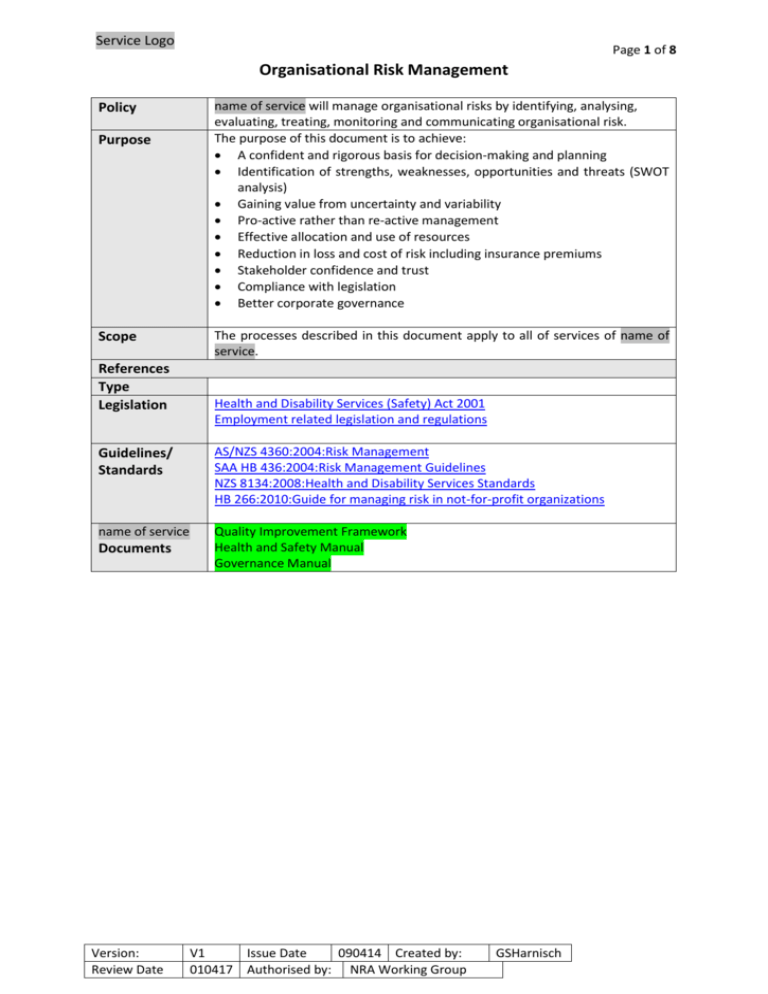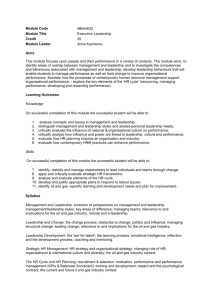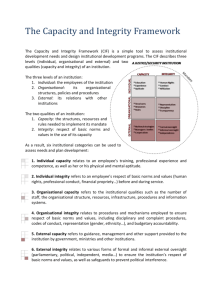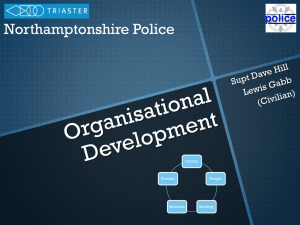Organisational Risk Management Policy and
advertisement

Service Logo Page 1 of 8 Organisational Risk Management Policy Purpose Scope References Type Legislation name of service will manage organisational risks by identifying, analysing, evaluating, treating, monitoring and communicating organisational risk. The purpose of this document is to achieve: A confident and rigorous basis for decision-making and planning Identification of strengths, weaknesses, opportunities and threats (SWOT analysis) Gaining value from uncertainty and variability Pro-active rather than re-active management Effective allocation and use of resources Reduction in loss and cost of risk including insurance premiums Stakeholder confidence and trust Compliance with legislation Better corporate governance The processes described in this document apply to all of services of name of service. Health and Disability Services (Safety) Act 2001 Employment related legislation and regulations Guidelines/ Standards AS/NZS 4360:2004:Risk Management SAA HB 436:2004:Risk Management Guidelines NZS 8134:2008:Health and Disability Services Standards HB 266:2010:Guide for managing risk in not-for-profit organizations name of service Quality Improvement Framework Health and Safety Manual Governance Manual Documents Version: Review Date V1 Issue Date 090414 Created by: 010417 Authorised by: NRA Working Group GSHarnisch Service Logo Page 2 of 8 Organisational Risk Management Definitions Consequence Outcome or impact of an event Control Event A process or other action that acts to minimise negative risk or enhance positive opportunity, Occurrence of a particular set of circumstances Hazard A source of potential harm Likelihood General description of probability or frequency Loss Monitor Probability Any negative consequence or adverse effect, financial or otherwise Check, supervise, observe critically or measure the progress of an activity, action or system on a regular basis in order to identify change from the performance level required or expected. Measure of the chance of occurrence. Risk The chance of something happening that will have an impact on objectives Benefits of risk management Fewer surprises Exploitation of opportunities Improved planning, performance and effectiveness Economy and efficiency Improved stakeholder relationships Improved information for decision making Enhanced reputation Director protection Accountability, assurance and governance Personal wellbeing. name of service Risk Management processes and the Organisational Risk Management Plan will consider the following: Applications of risk management name of service will Strategic, operational and business planning develop and Asset management and resource planning maintain a yearly Business interruption and continuity risk management Organisational, technological and political change plan in the Environmental issues following areas: Ethics, fraud and security Resource allocation Directors’, Board of Trustee and officers liability Compliance Operations and maintenance systems Health and Safety Human Resources Project Management Purchasing and contract management Version: Review Date V1 Issue Date 090414 Created by: 010417 Authorised by: NRA Working Group GSHarnisch Service Logo Page 3 of 8 Organisational Risk Management Information Management Risk Management Processes The Risk management plan will consider the following processes and systems: Communication and Consultation Establishing the context name of service will communicate and consult with internal and external stakeholders as appropriate at each stage of the risk management processes. The following stakeholders have been identified for this process: Internal Stakeholders External Stakeholders Board of Trustees DHB Funding and Planning Manager DHB Provider Arm Health Professional and Support ……….PHO Staff ........ Accountant Service users Mana Whenua Iwi organisations Other NGO’s /Navigate Contractors and suppliers Emergency services Financial Institutions Family/whanau of service users Statutory Agencies Government Agencies Client Support Agencies Family Support Agencies External and internal and risk management context in which the described processes will take place will be established. Internal Context External Context Organisational culture Regulatory and Legislative Requirements Internal stakeholders Competing Non Government Company Structures Health Organisation Resources: Political environment o Human Resources o Systems Social Obligations o Processes Bi-and multicultural environment o Capital Auckland Council Unitary Strategic Plan Plan/Resource Management Plan Financial environment Business environment External stakeholders Risk Identification Where, when, why and how events could prevent, degrade, delay or enhance the achievement of organisational objectives. Risk Analysis Identification and evaluation of existing controls. Determination of consequences and likelihood = level of risk. The analysis will consider the range of potential consequences and how these could occur. Version: Review Date V1 Issue Date 090414 Created by: 010417 Authorised by: NRA Working Group GSHarnisch Service Logo Page 4 of 8 Organisational Risk Management Risk Evaluation Comparison of estimated levels of risk against the pre-established criteria. Consideration of the balance between potential benefits and adverse outcomes. Risk Treatment The plan will show the development and implementation of specific cost-effective strategies and action plans to increase potential benefits and reduce potential costs. Monitoring and Review The effectiveness of the Risk Management plan will be monitored. RISK MANAGEMENT PROCESSES - OVERVIEW IDENTIFY RISKS MONITOR AND REVIEW COMMUNICATE AND CONSULT ESTABLISH THE CONTEXT ANALYSE RISKS EVALUATE RISKS 4 TREAT RISKS Version: Review Date V1 Issue Date 090414 Created by: 010417 Authorised by: NRA Working Group GSHarnisch Service Logo Page 5 of 8 Organisational Risk Management name of service Organisational Risk Management Plan Template for Risk Rating Risk Management Risk Strategic, operational and business planning Asset management and resource planning Business interruption and continuity Organisational, technological and political change Environmental issues Ethics, fraud and security Resource allocation Board of Trustees and officers liability Version: Review Date V1 Issue Date 090414 Created by: 010417 Authorised by: NRA Working Group GSHarnisch Responsibilities Service Logo Page 6 of 8 Organisational Risk Management Risk Risk Rating Risk Management Compliance Operations and maintenance systems Health and Safety Human Resources Project Management Purchasing and contract management Information Management Version: Review Date V1 Issue Date 090414 Created by: 010417 Authorised by: NRA Working Group GSHarnisch Responsibilities Service Logo Page 7 of 8 Organisational Risk Management Risk Rating Guideline Extreme Very High Medium Low Negligible Version: Review Date The consequences would threaten: The survival of the service , possibly causing major problems for clients and their families The administration of the programme or for a large part of the Public Sector. Revenue loss greater than 30% of total revenue being managed would have extreme consequences for the organisation both financially and politically The consequences would threaten: The survival or continued effective function of the service Revenue loss greater than 15% of total revenue being managed Would have very high consequences for the organisation both financially and politically The consequences would not threaten the programme But would mean that the administration of the programme could be subject to significant review or changed ways of operating. Revenue loss greater than 8% of total revenue being managed Would have ……consequences for the organisation both financially and politically The consequences would: Threaten the efficiency or effectiveness of some aspects of the service Be dealt with internally. A loss of revenue below the tolerance level of 5% Would be of low consequence The consequences are dealt with by routine operations. A loss of revenue below the programme tolerance level of 3% Would be of negligible consequence V1 Issue Date 090414 Created by: 010417 Authorised by: NRA Working Group GSHarnisch Service Logo Page 8 of 8 Organisational Risk Management Risk Rating Matrix Consequences Likelihood A (almost certain) B (likely) C (moderate) D (unlikely) E (rare) Negligible 1 N N N N N Low 2 L L L N N Medium 3 M M M L L E: Extreme Risk; Immediate attention required H: High Risk; senior management attention needed M: Moderate Risk; management responsibility must be specified L: Low Risk; manage by routine procedures N: Negligible; unlikely to need specific application of resources. Version: Review Date V1 Issue Date 090414 Created by: 010417 Authorised by: NRA Working Group GSHarnisch Very High 4 E H M M M Extreme 5 E H H H H








